Comptroller Kevin Lembo Archive > News
COMPTROLLER LEMBO PROJECTS $161.7-MILLION DEFICIT FOR FISCAL YEAR 2015 FOLLOWING LAST MONTH'S RESCISSIONSIn a letter to Gov. Dannel P. Malloy, Lembo said that he is in general agreement with the Office of Policy and Management's (OPM) revised projection released Thursday.
"Last month, my Fiscal Year 2015 General Fund projection anticipated revenue would be $40 million lower than the number that OPM was projecting at the time," Lembo reported. "As a result of the April 30 consensus revenue forecast, OPM's net revenue projection is now $500,000 below my estimate of last month. I have accounted for the small net revenue change, as well as an additional $11.6 million in net spending reductions due to (the administration's) April rescissions."
Overall, General Fund revenue this fiscal year is projected to fall $166.1 million short of original budget projections. The largest shortfalls are related to federal grants, the health provider tax and the income tax. The most significant revenue gains are in the sales tax and the corporation tax.
OPM has reported plans to save $285.8 million by the end of the fiscal year, which Lembo said is "well within the range of lapses experienced over the past five fiscal years." Over those five years, multiple administrations have achieved average annual savings targets of $511.2 million.
"As I have been reporting, the state's overall economic climate has been gradually improving," Lembo said.
Lembo pointed to the latest economic indicators from federal and state Departments of Labor and other sources that show:

Through the first nine months of Fiscal Year 2015, the year-to-date withholding portion of the income tax was running 2.5 percent above the same period last year. For most of Fiscal Year 2015, withholding receipts have been running close to the gains experienced in the prior year.
Withholding receipts have yet to attain pre-recession growth rates. The large revenue increases in Fiscal Years 2011 and 2012 were almost entirely attributable to higher income tax rates. Net of those tax increases, withholding receipts were stagnant in both Fiscal Year 2011 and Fiscal Year 2012. The poor performance also continued through Fiscal Year 2013. In Fiscal Year 2015, despite improving employment statistics, the withholding tax has yet to establish a pattern of consistent accelerating growth.
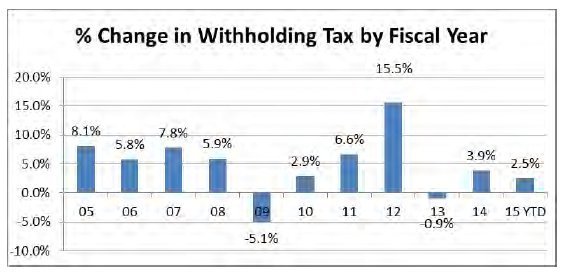
According to the Department of Labor,
preliminary figures show that Connecticut gained 4,000 payroll positions in
March. Seasonally adjusted year-to-date employment growth in the first quarter
of 2015 was estimated at 8,600, compared to 6,600 jobs over the same period in
2014.

Connecticut has now recovered 92,700
positions, or 77.9 percent of the 119,000 seasonally adjusted total nonfarm jobs
that were lost in the state during the March 2008 - February 2010 employment
recession. Connecticut's jobs recovery is now 61 months old and is averaging
1,520 jobs per month since February 2010. The state needs another 26,300 jobs to
reach the 1,713,000 employment level attained before the recession.
The table below shows the distribution of employment gains and losses by major
employment sector over the latest 12-month period ending in March.
Job additions in Connecticut during this period total 27,100.
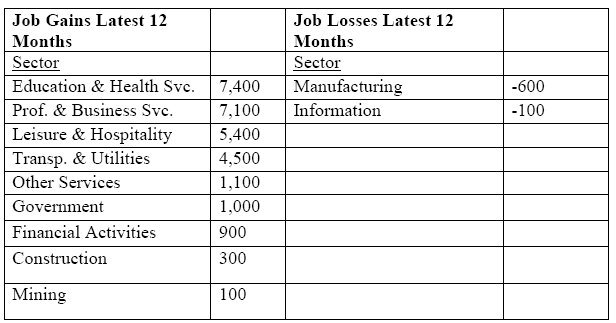
U.S. employment has been advancing at a rate of 2.3 percent over the 12-month
period ending in March; Connecticut's employment growth was 1.6 percent for the
same period.
Connecticut's unemployment rate was 6.4 percent in March; the national
unemployment rate was 5.5 percent. Connecticut's unemployment rate has continued
to decline from a high of 9.5 percent in October 2010.
There are approximately 121,900 unemployed workers in Connecticut. A low of
36,500 unemployed workers was recorded in October of 2000. The number of
unemployed state workers hit a recessionary high of 177,200 in December of 2010.
![]()
The Department of Labor reports that average hourly earnings at $29.06, not
seasonally adjusted, were up 91 cents, or 3.2 percent, from the March 2014
estimate. The resulting average private sector weekly pay was estimated at
$976.42, up $30.58, or 3.2 percent higher over the year. Wages appear to be
establishing a more consistent upward trend.
The year-to-year change in the Consumer Price Index for All Urban Consumers
(CPI-U, U.S. City Average, not seasonally adjusted) in March 2015 was -0.1
percent (deflating).
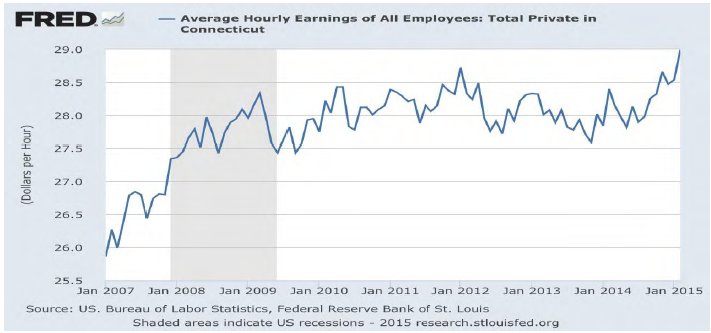
Based on data released by the Bureau of
Economic Analysis on March 25 for calendar year 2014, personal income in
Connecticut grew at a rate of 3 percent between 2013 and 2014; however,
annualized growth for the first quarter was just over 4 percent. Connecticut was
ranked 39th nationally in personal income growth in 2014, but ranked 22nd in
fourth-quarter income growth. Results for the first quarter of 2015 will be
released on June 22.
The chart below shows the annual trend in Connecticut personal income over
time,
which is well off the pace set during the last post-recessionary period.
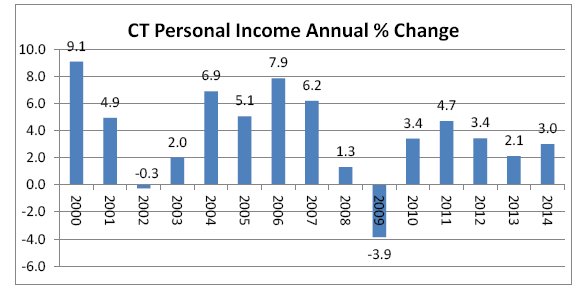

The Real Estate Conveyance Tax is trending 2.1 percent ahead of collections
through March of last year.
According to a report from the Warren Group released on April 8, Connecticut
single-family home sales rose 13.8 percent in February from the same month last
year. This follows a 6.3-percent sales decline in January. The state has
experienced sales increases in five of the last six months. This was the
strongest February increase since 2008. The median price of a single-family home
fell by almost 5 percent in February to $224,750 from $236,000 a year ago. The
only year of the last four that posted a price gain was 2013. Declines
experienced in 2015 are following a pattern similar to last year.
The National Association of Realtors reported that existing U.S. home sales in
March were up 10.4 percent from the same period last year and prices were up 7.8
percent to $212,100. The Association reported that the positive sales results
were experienced in all regions of the country.
Consumers
Sales tax receipts through February of Fiscal Year 2015 were up 3.2 percent
over last year. The sales tax is on track to complete the year almost $60
million above the original budget estimate.
Advance retail sales were up 1.3 percent in March from the same month last
year.
For the first quarter of 2015 sales were advancing at a 2.2-percent rate. Food
services and drinking places had the strongest gain at 7.7 percent. Building
material, gardening and supplies stores posted a March gain of 6.3 percent. Auto
sales were down slightly from earlier in the year, growing 5.8 percent. Gasoline
stations posted the largest sales decline at -22 percent due to lower prices.
Department stores also experienced a decrease in sales.
According to the University of Michigan's consumer sentiment index, consumer
optimism rebounded in early April to its second highest level since 2007. More
importantly, consumer optimism has recorded a higher average level during the
last five months than any time since May 2004.
There were some important exceptions to the index trend. The consumer outlook
for income gains remained weak. While expected income gains have improved over
the recent recession lows, the actual gains in income have been unimpressive for
a recovery period. Although lower inflation expectations have acted to bolster
real income expectations, they also still remain at historically low levels.
Consumers' spending has become increasingly dependent on low interest rates even
as they widely expect interest rate increases during the year ahead.
Importantly, few consumers now anticipate that the Fed would raise rates enough
to affect their current purchase plans. Overall, the data continue to support a
3.3-percent growth rate in personal consumption expenditures during 2015, even
with a weather diminished 1st quarter performance.
The Federal Reserve reported that February consumer credit increased at a
seasonally adjusted annual rate of 5.5 percent. Revolving credit, primarily
credit cards, decreased at an annual rate of 5 percent, while non-revolving
credit, which includes auto loans and student loans, increased at an annual rate
of 9.5 percent. Revolving credit has been following a downward trend; while
non-revolving credit has been trending upward.
Business and Economic Growth
Based on the April 29 advance estimate by the Bureau of Economic Analysis,
real GDP increased at a rate of 0.2 percent in the first quarter of 2015. In the
fourth quarter of 2014 real GDP increased at a 2.2-percent rate. The second
estimate for the first quarter will be released on May 29.
The deceleration in real GDP growth in the first quarter reflected a
deceleration in personal consumption expenditures, downturns in exports, in
nonresidential fixed investment and in state and local government spending, and
a deceleration in residential fixed investment that were partly offset by a
deceleration in imports and upturns in private inventory investment and in
federal government spending.
Corporate profits were down slightly in 2014. After gains in the second and
third quarters of 2014, profits fell in the fourth quarter. The first-quarter
preliminary profit report will be released on May 29.
The Department of Labor's General Drift Indicators are composite measures of
the four-quarter change in three coincident (Connecticut Manufacturing
Production Index, nonfarm employment, and real personal income) and four leading
(housing permits, manufacturing average weekly hours, Hartford help-wanted
advertising, and initial unemployment claims) economic variables, and are
indexed so 1986 = 100. The index has been showing a general upward trend,
although it remains well below pre-recession levels.

Stock Market
Estimated income tax payments, which are influenced by capital gains receipts,
were trending 5.1 percent higher on a year-to-date basis thru March from the
same period one year ago. The chart below shows the trends in estimated and
final income tax payments since 2005. Generally, less than one quarter of total
final payments have been received by March. April is the single most significant
month for state revenue analysis. The books for April, on which we base our
data, will not close until May 15 in order to account for any adjustments to
revenue coding.
If current payroll withholding growth and estimated payment growth remain at
March year-to-date levels, then the April income tax final receipts must grow by
25 percent over last April to achieve the budget projection for the income tax.
At this writing, April final payments to date were posting double digit growth
against last April, but had not attained the 25-percent level.
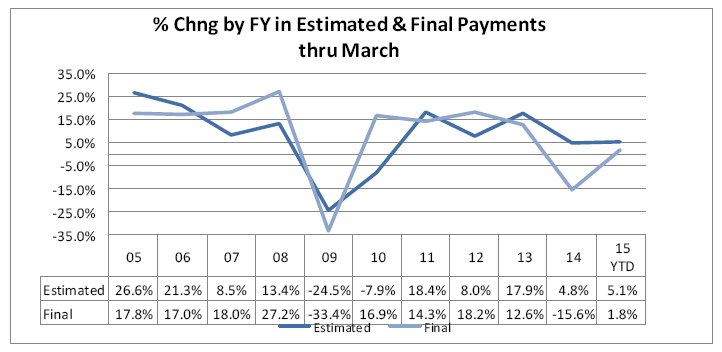
Over the past 12 months the Dow has posted a gain of 10.1 percent with
significant monthly swings.
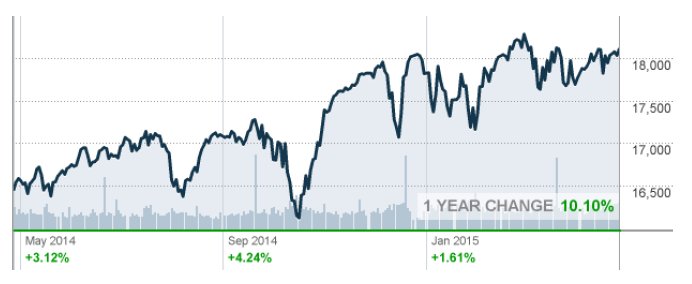
As a result of the monthly volatility, the Dow gain on a year-to-date basis
has been less than 2 percent.
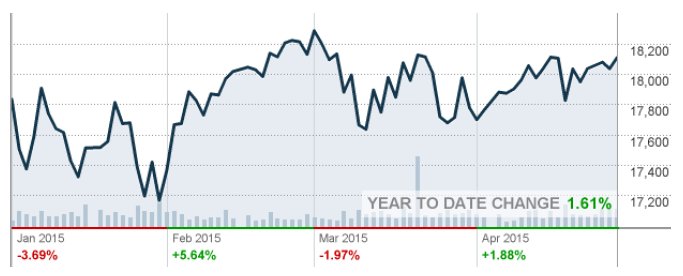
***END***
